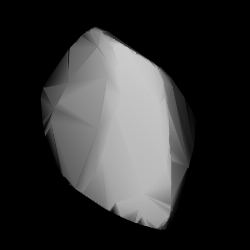Top Qs
Timeline
Chat
Perspective
5027 Androgeos
Asteroid in the orbit of Jupiter From Wikipedia, the free encyclopedia
Remove ads
5027 Androgeos /ænˈdroʊdʒiəs/ is a large Jupiter trojan from the Greek camp, approximately 59 kilometers (37 miles) in diameter. It was discovered on 21 January 1988, by American astronomer Carolyn Shoemaker at the Palomar Observatory in California.[1] The dark D-type asteroid is one of the 70 largest Jupiter trojans and has a rotation period of 11.4 hours.[9] It was named after the warrior Androgeos from Greek mythology, who was killed by Aeneas.[1]
Remove ads
Orbit and classification
Androgeos is a dark Jovian asteroid orbiting in the leading Greek camp at Jupiter's L4 Lagrangian point, 60° ahead of the Gas Giant's orbit in a 1:1 resonance . It is also a non-family asteroid in the Jovian background population.[5]
It orbits the Sun at a distance of 4.95–5.65 AU once every 12 years and 3 months (4,459 days; semi-major axis of 5.30 AU). Its orbit has an eccentricity of 0.07 and an inclination of 31° with respect to the ecliptic.[3] The body's observation arc begins with its official discovery observation at Palomar.[1]
Remove ads
Naming
This minor planet was named, by the discoverer, after the Greek warrior Androgeos from Greek mythology, who was killed by Aeneas in the burning city of Troy. Aeneas and his Trojan men then took the armor of Androgeos and his killed troops to disguise themselves and escape to safety. The official naming citation was published by the Minor Planet Center on 4 June 1993 (M.P.C. 22248).[12]
Physical characteristics
Summarize
Perspective
Androgeos has been characterized as a dark D-type asteroid by Pan-STARRS' survey and in the SDSS-based taxonomy.[9][10][11]
Rotation period
In May 2016, a rotational lightcurve of Androgeos was obtained from photometric observations by Robert Stephens at the Center for Solar System Studies in California. Lightcurve analysis gave a rotation period of 11.376±0.004 hours with a brightness amplitude of 0.37 magnitude (U=3).[9][8][a]
This result supersedes similar period determinations with an amplitude of 0.31 and 0.64 by Stefano Mottola (1992) Stephens (2015), respectively (U=3).[9][13][14][a]
Diameter and albedo
According to the survey carried out by the Infrared Astronomical Satellite IRAS and the NEOWISE mission of NASA's Wide-field Infrared Survey Explorer, Androgeos measures 57.86 and 59.79 kilometers in diameter and its surface has an albedo of 0.091 and 0.071, respectively.[6][7] The Collaborative Asteroid Lightcurve Link derives an albedo of 0.0767 and a diameter of 57.68 kilometers based on an absolute magnitude of 9.6.[9]
100+ largest Jupiter trojans
Remove ads
Notes
References
External links
Wikiwand - on
Seamless Wikipedia browsing. On steroids.
Remove ads

